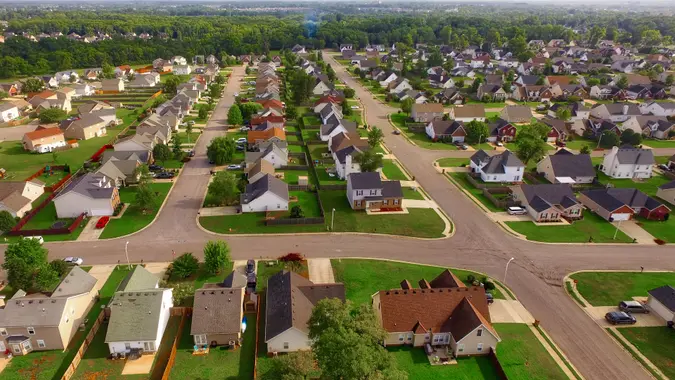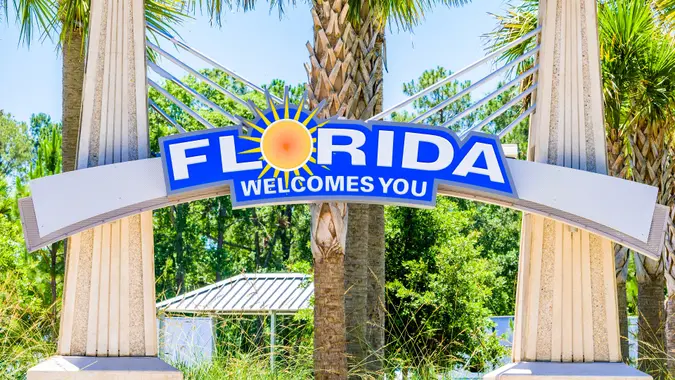Tax Credits for Eco-Friendly Remodels and Energy-Efficient Upgrades in 2025

Commitment to Our Readers
GOBankingRates' editorial team is committed to bringing you unbiased reviews and information. We use data-driven methodologies to evaluate financial products and services - our reviews and ratings are not influenced by advertisers. You can read more about our editorial guidelines and our products and services review methodology.

20 Years
Helping You Live Richer

Reviewed
by Experts

Trusted by
Millions of Readers
Today’s homebuyers often look for “green” construction – homes built with environmental considerations in mind. And when buying a previously owned home, some buyers also seek eco-friendly materials and options.
Learn More: 25 Safest and Cheapest Cities To Live in the South
For You:
In fact, Zillow reports that homes equipped with some environmentally friendly features frequently will sell faster, and for more money, than properties without similar items. If you want to list your home on the market in 2025, or remodel it for your own enjoyment, following these five suggestions in a home renovation project will likely boost your home’s value.
What Are Eco-Friendly Remodel Tax Credits?
The government incentivizes eco-friendly home improvements through tax credits and rebates. This means you can get money back when you choose more energy-efficient and “green” materials on your home improvement projects.
There are two main tax credits available today — the Residential Clean Energy Credit and the Energy Efficient Home Improvement Credit.
Residential Clean Energy Credit. You can claim up to 30% of the cost of clean energy improvements to your home, including solar, wind, geothermal, fuel cells or battery storage technology. There are no limits on the credit except a fuel cell property limit of $500 for each half kilowatt of capacity.
Energy Efficient Home Improvement Credit. The energy-efficient home improvement credit offers tax credits of up to $2,000 for heat pumps or biomass stoves or boilers, and up to $1,200 for other energy-efficient property upgrades. Other improvements include energy-efficient exterior doors, windows, skylights, inclusion and A/C units, plus a credit for home energy audits.
In addition to federal eco-friendly tax credits, certain state and local tax incentives and rebates may be available.
Eligible Eco-Friendly Home Improvements
There are several eco-friendly home improvements that can net you thousands of dollars in tax credits. Here are a few that qualify:
1. Solar Panels and Solar Water Heaters
If you install solar panels or a solar water heater, you may get up to 30% of the cost as a tax credit. According to the IRS, “qualified expenses may include labor costs for onsite preparation, assembly or original installation of the property and for piping or wiring to connect it to the home.”
It’s important to note that the solar water heaters must be certified by the Solar Rating Certification Corporation (SRCC) to qualify. Also, this is a nonrefundable credit, it can only reduce your taxes owed down to $0.
2. Energy-Efficient Windows, Doors and Insulation
If you install energy-efficient windows, exterior doors, skylights or insulation, you may qualify for the Energy Efficient Home Improvement Credit. Here’s how much you can claim for each:
- Up to $250 per door (up to $500 total)
- Up to $600 total for windows or skylights
- Up to $1,200 in tax credits for qualifying insulation
The doors, windows and skylights must meet or exceed Energy Star requirements. And the insulation or air sealing material upgrades must meet the International Energy Conservation Code (IECC) standards to qualify.
3. Heat Pumps and HVAC Systems
If you install a new heat pump or air conditioning unit on your home, you may qualify for the Energy Efficient Home Improvement Credit. Here’s how much you can get back:
- Up to $2,000 for qualifying heat pumps
- Up to $600 for a qualifying central air conditioner
The qualifying heat pump or air conditioner must meet or exceed the Consortium for Energy Efficiency (CEE) highest efficiency tier.
4. Geothermal Systems
Certain geothermal systems may qualify for the Residential Clean Energy Credit. This means you can get a credit for up to 30% of the total cost of installing a geothermal heat pump. Geothermal heat pumps must meet Energy Star requirements in effect at the time of purchase to qualify for the credit.
How to Claim Tax Credits for Eco-Friendly Upgrades
To claim the Residential Clean Energy Credit or the Energy-Efficient Home Improvement Credit on your tax return, here’s what you need to do:
- Collect all paperwork. Depending on the upgrade you are claiming, there are paperwork requirements. You’ll need your purchase receipt and Energy Star (or other certification) information for certain upgrades, or written proof of the eligibility of the item purchased.
- Fill out IRS Form 5695. To claim energy tax credits, you’ll need to complete IRS Form 5695. This form allows you to input the amounts paid for qualifying home upgrades, and calculate the amount of the credit itself. There are several pages of inputs and qualifying questions to answer to help you claim the right amount.
- Submit form 5695 and paperwork with your tax return. When you submit your tax return, you’ll need to attach the required paperwork and Form 5695 to your return to claim the credit.
- Do your taxes online. Many tax software companies allow you to complete the required forms automatically when claiming the energy-efficient credits. This can help you calculate what you qualify for and avoid mistakes.
State and Local Incentives for Green Remodeling
Some state and local utility providers offer rebates and incentives for energy-efficient upgrades based on the Inflation Reduction Act (IRA). There may be income limits on these rebates, as most are designed to help low- and medium-income families. You may need to earn 80% of the area median income (AMI) or less to qualify — though some households may get some of the rebate amount with income up to 150% of the AMI.
Not all rebates are available in all states, but here’s a quick overview of what may be available to you:
Home upgrades rebate. Up to $8,000 in qualified energy-efficient upgrades to an existing home. This may include upgrades to windows, doors, HVAC, electric panels and other areas that increase energy savings by a certain amount (usually 20% or more). Not all states offer these rebates, a map of the status of each state can be found here.
Home appliance rebate. Some states offer a rebate of up to $14,000 for energy-efficient home appliances upgrades. This may include upgraded heat pumps, water heaters, stoves, dryers, and more.
Financial and Environmental Benefits of Eco-Friendly Upgrades
In addition to the tax savings available from the energy-efficient tax incentives and rebates — you’ll also be helping the environment. The idea behind incentivizing “green” upgrades to your home is to use less energy, lower your pollution and reduce your carbon footprint. This can lower the impact to the environment you live in.
The Bottom Line
There are thousands of dollars available in eco-friendly tax credits and state rebates that can help save money when upgrading your home. If you plan correctly, you can get paid back dollar-for-dollar when getting a new HVAC system, adding new insulation, replacing doors and windows, or adding solar panels to your home. Just make sure to understand the limits and requirements for qualifying for the tax credit and rebates to ensure you get the amount you’re entitled to.
Jami Farkas contributed to the reporting of this article.
Our in-house research team and on-site financial experts work together to create content that’s accurate, impartial, and up to date. We fact-check every single statistic, quote and fact using trusted primary resources to make sure the information we provide is correct. You can learn more about GOBankingRates’ processes and standards in our editorial policy.
 Written by
Written by  Edited by
Edited by 

























